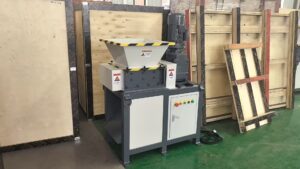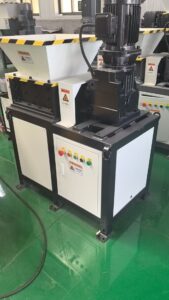In the era of rising environmental awareness and increasing industrial and household waste, having an efficient solution to manage and reduce waste volume is more important than ever. For small-scale businesses, workshops, recycling centers, and even individual users, the small shredder machine has become a game-changing tool. This article explores everything you need to know about small shredders — what they are, how they work, their applications, and why they might be exactly what your operation needs.
What is a Small Shredder Machine?

A small shredder machine, also known as a compact shredder, is a mechanical device designed to reduce the size of various types of materials through cutting, shearing, or tearing. Unlike large industrial shredders, small shredders are built to be space-efficient and energy-efficient, making them ideal for businesses or users with limited space or lower capacity needs.
Despite their compact size, these machines are capable of handling a wide range of materials, including:
-
Plastic (bottles, films, containers)
-
Rubber
-
Cardboard and paper
-
Electronic waste (e-waste)
-
Aluminum cans
-
Textile and fabric scraps
-
Light wood or pallets (depending on the model)
How Does a Small Shredder Work?

The core mechanism of a small shredder involves a set of rotating blades or shafts. When material is fed into the machine, it is grabbed by the blades and shredded into smaller, manageable pieces. The output size can usually be adjusted by changing the screen or the spacing between the blades.
Key components typically include:
-
Feeding hopper: Where materials are loaded
-
Cutting chamber: The heart of the machine with rotary and/or fixed blades
-
Motor and gearbox: Provide power and speed regulation
-
Output chute or conveyor: For collecting shredded material
Some advanced models also come with features like overload protection, automatic reverse, and noise-reduction design.
Why Choose a Small Shredder Machine?
Here are several compelling reasons why small shredders are gaining popularity:
1. Space-Saving Design
Small shredders are perfect for locations where space is a constraint. They can be placed in workshops, garages, or inside recycling stations without requiring large floor areas.
2. Cost-Effective
They are generally more affordable than large industrial machines, making them ideal for small businesses, startups, or community recycling projects.
3. Energy Efficiency
Smaller shredders consume less power while still delivering effective performance, helping users save on electricity bills.
4. Multi-Material Capability
Modern small shredders are surprisingly versatile. With the right blade configuration, a single unit can process a variety of waste types.
5. Ease of Operation and Maintenance
These machines are usually simple to operate, often requiring just one person to run. Maintenance is also straightforward, with easy access to blades and chambers for cleaning or replacement.
Common Applications of Small Shredders
The potential uses of small shredders are diverse and span across industries:
🔹 Recycling Centers
Used for pre-processing plastic bottles, packaging waste, and light metals before further separation or granulation.
🔹 Small Manufacturing Units
Perfect for managing production waste like offcuts, rejected parts, or packaging remnants.
🔹 Schools and Offices
Used to dispose of large volumes of paper waste or outdated documents.
🔹 Electronic Waste Processing
Ideal for breaking down small electronic devices such as mobile phones, circuit boards, and cables.
🔹 Agricultural Waste Management
Can be used to shred crop stalks, small branches, or plastic mulch film.
Choosing the Right Small Shredder Machine
When selecting a small shredder for your needs, consider the following factors:
-
Type of material you need to shred regularly
-
Output size requirement
-
Hourly capacity (kg/h or pieces/hour)
-
Power supply (single phase or three phase)
-
Blade type and durability
-
Noise level — important for indoor or office use
-
Safety features such as emergency stop or automatic reverse
You should also consider whether you need a single-shaft or dual-shaft shredder. Single-shaft models are good for uniform material and size control, while dual-shaft shredders are more robust and better for mixed or hard-to-shred items.
Real-Life Case Study
Case: A Small E-Waste Recycling Shop in the UK
A small electronics repair and recycling business based in Manchester invested in a 4kW dual-shaft small shredder machine. Within weeks, the team reduced the storage space required for discarded devices by 60% and improved their metal recovery rate by 30%. The operator noted the following benefits:
-
Quiet operation inside a workshop
-
Safe, simple handling even for a non-technical team
-
Compact footprint fit neatly into their storage room
-
ROI achieved in under 6 months
Maintenance Tips
To extend the life and performance of your small shredder:
-
Lubricate moving parts regularly
-
Clean the blades and chamber after each use
-
Avoid feeding unapproved or oversized materials
-
Replace worn blades in time
-
Keep the control panel clean and dry
Some manufacturers also offer optional spare blade kits and maintenance service plans.
Conclusion: Small Machine, Big Impact
The small shredder machine may be compact in size, but its impact on waste reduction and operational efficiency is anything but small. Whether you’re a recycler, a small business owner, or someone looking to reduce waste at the source, a small shredder is a smart investment for environmental and economic reasons alike.
If you’re considering purchasing a small shredder, be sure to evaluate your material type, output needs, and available space. Choosing the right model can help you transform how you manage waste — and contribute to a cleaner, more sustainable future.
Need a reliable small shredder machine?
At [Your Brand], we offer CE-certified compact shredders with customizable blade sizes and power options. Contact us today for a free quote or consultation!
